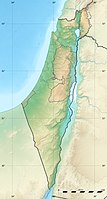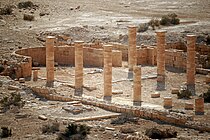The place Nitzana is a border town on the Egyptian border with Sinai in the western Negev desert in Israel. Here is the one Nitzana National Park . The archaeological site includes the Tel Nitzana, a settlement mound with ruins one Nabataean city.
background

Like others Nabataean cities in the Negev became the city Nitzana probably in the 3rd century B.C. founded, probably as a caravan station on a branch of the river leading into Sinai Incense Routecoming across from the Arabian Peninsula Petra to Gaza led.
In the first century the region came under the rule of the Romans. In the 4th century the Nabataeans joined the Christian religion. The region was now ruled by the Byzantines. During this time the church was fortified in the northern part of the city. In the 7th century the city was conquered by the Muslims advancing from Syria and, after a population decline, probably in the 8th century. given up. The ruins of the city were used as building material for numerous buildings in Gaza, so little of the ruins has survived.
Later the border town became at the crossroads and the border crossing between the Ottoman-Turkish Empire and Egypt Auja al-Hafir built. In 1902 the Ottoman administration established a police station and later a military base. The Turkish troops deployed to attack the Suez Canal in 1915 were transferred via the Ottoman military railway, built in 1905/15 Be'er Sheva and a traffic junction with administrative buildings developed on the only paved road between the Mandate Palestine and Egypt. A prison was set up by the mandate administration, in which Arab Palestinian leaders and Jewish communists alike were held.
The site was occupied during the Israeli War of Independence and the Egyptian garrison was recaptured by Israeli troops at the Battle of 'Auja. First, a demilitarized zone of Auja was established under the supervision of the United Nations. After bloody skirmishes over the definitive border with Egypt, Nitzana was occupied by Israeli troops after the withdrawal from Sinai in 1955 and integrated into Israeli territory after the defeat of Egypt in the Six Day War in 1967.
Not far from the Nitzana Border Crossing to Egypt, which is only open to commercial traffic, a settlement developed with a youth village and activities in the agricultural sector and solar energy research.
In the 19th century the ruins were described in various travelogues, but not yet correctly identified. In 1896/1902 the Czech Alois Musil found the ruins largely intact. The construction activity of the Ottoman Empire resulted in its extensive destruction. In the years 1935/37, the first systematic excavations of the Nabatean city were carried out by Harris Dunscombe Colt under the British mandate government. With the Nessana papyri a larger conglomerate of scrolls in Greek and Arabic was discovered, which provide information about life in the city in the post-Nabatean and Byzantine times. So the city was a stopover for the pilgrims to the Katharinenkloster in Sinai. The scrolls with tax data bear witness to a city with 1,500 inhabitants in 116 houses.
Further excavations took place in 1987/95 under D. Urman and J Shereshevski from Ben Gurion University.
getting there
The southwest of Beer Sheva The city located near the Egyptian border is best reached with your own vehicle: from the well-developed road 40 from the north over Beer Sheva in the direction Mizpe Ramon - Eilat you bend at the Tlalim Junction on the street 211 from. This leads in a westerly direction Nitzana and to the Egyptian border.
To arrive by public transport, take from the bus station from Beer Sheva the bus route 44 the bus company Metropolinethat about every two hours on the road 211 runs to Nitzana and the Nitzana Border Crossing. From the entrance to the village, Tel Nitzana, a good 2 km away, can be reached on foot in about 30 minutes.
mobility
Locally one moves on foot. Travelers with walking difficulties can circle the Tel Nitzana from the northeast on a gravel road and park just below the hilltop of the Tel.
Tourist Attractions



Tel Nitzana Archeological Park
The ancient city extends over the two-part settlement hill (with the upper town) to the west and the lower town with the south church and cisterns in the east of the crossing Nahal Ezuz.
- From the parking lot north-west of Tel Nitzana, you can comfortably climb (green and white route) to the saddle between the two parts of the upper town on Tel Nitzana.
- To the right in the southwest are the ruins of the 1 Southern Churchwhich, however, is difficult to identify as a church building. A little below there are ruins of residential quarters.
- Prominent are the modern ruins of the Ottoman governor's seat and the Turkish-German military hospital, which were built over the ruins of the Nabatean - Byzantine fortress without much consideration for the ancient structures. To the north is the 2 citadel, of which an entrance gate and part of the surrounding wall have been preserved.
- To the north it closes Northern Church at. In addition to the round arch of the apse, remains of the baptismal font, the baptistery and cisterns have been preserved. In the church resp. in a vault below that of Saints Bacchus and Sergius, probably AD 464. built church became part of the Papyri by Nitzana found.
- A well-preserved one 3 Staircase had connected the lower town with the upper town with the citadel in antiquity. At the foot of the settlement hill there are ruins of residential quarters.
- After the passage over the Nahal Ezuz, which falls dry in the summer months, there are several secured with bars on the left Cisternsat the bottom of which water collects.
- In the southeast of the lower town lie the ruins of the 4 Eastern Church, of which, in addition to two rows of columns, the main apses and apses of side chapels can be made out.
- In the vicinity you can reach the water channels of a well system that was still used in Ottoman times.
Nitzana Hillocks

A graveled spur road leads to a parking lot from which the protected area of the 5 Nitzana Hillocks is easily reached on foot. Rainwater has washed picturesque little gullies and gorges out of the dazzling white limestone. The rocks were partly polished smooth by the weather and provide picturesque photo motifs.
further sights around Nitzana


- The 6 Khativa 8 Memorial, which commemorates the deaths of the Israeli reconquest of Nitzana, lies northeast of Tel Nitzana.
- On the blue and white marked route you can go to 7 Nitzana Cave hike. The 80 x 20 m large cave was created by the exploitation of the limestone by the Nabataeans, who literally hollowed out the limestone hill inside. The pillars, which have been left as supporting pillars, are clearly recognizable. Over the centuries, parts of the ceiling have collapsed as a result of earthquakes.
- The blue-and-white marked route leads to a terrace laid out in the area of ancient Nabatean terraces 8 Ancient Agriculturegrove with various fruit trees ("Ancient Agriculture", inscription in Hebrew) and past the long row of columns of the 9 "Path of Peace" / "Netiv Shalom" to the starting point.
- On the road leading south towards Ezuz there are remains of the Ottoman military railway and an oval one 10 Turkish tower, which probably served as a water tower.
activities
- sightseeing of the Archaeological Park on Tel Nitzana
- Short hikes to the cave Nitzana Cave and the white rocks of the Nitzana Hillocks.
shop
There are no shops on site and there is no presence of the national park administration with a souvenir shop or similar.
kitchen
- In a 1 pub in a forest of shadows opposite the entrance to the village, built on a converted truck trailer, simple lunchtime meals and chilled drinks are served; Toilets.
accommodation
A number of overnight accommodations with guest rooms resp. B&B are offered to desert lovers in nearby Ezuz.
security
The security situation is harmless in terms of the proximity to the border as well as in terms of crime. The parking spaces outside the archaeological site are only partially within sight and are unguarded.
In the hot, dry desert climate, care must be taken to ensure that there is sufficient water and salt intake. However, the distances and height differences when visiting Nitzana are small.
trips
- Visiting the other Nabataean cities are to be mentioned above all Shivta, Avdat and Mamshit as Petra, the capital of the Nabataeans in Jordan.
1 Ezuz



The settlement was in the area of a former kibbutz outpost Ezuz Established in 1985 in the Nahal Ezuz area. Some of the residents are dedicated to organic farming and use ancient Nabataean methods of irrigation to make the land arable. Locally produced goat cheese and olive oil are offered on site.
Other focuses are Handicrafts and especially tourism. Many houses offer rooms and apartments. Hikes and bike tours are possible in the area. Ezuz also offers good birdwatching opportunities.
- The access road leads over the embankment of the Ottoman military railway and the well-preserved one 11 Osman Railway Bridgeturkish railway bridge.
- Near a shady, tree-lined picnic area, two ancient wells have been excavated, known as 12 Aaron's fountain and 13 Well of Moses were designated. There may be a connection between this place with two wells and the biblical one Be'erotayim, the "place of the two fountains".
- in the Nahal Be'erotayim there is a bricked one 14 Byzantine poolRetention basin ("Pool") from the Nabatean - Byzantine period. A system of water pipes brought the water from the winter rains to the basin. In the river valley there are also rock inscriptions, some in Greek.
Accommodation options:
- 1 Beaty Spot Ezuz, 85735 Ezuz. Tel.: 972 50 564 6277, Email: [email protected]. Accommodation and restaurant.
- 2 Room bus, The Well Guesthouses, 85735 Ezuz. Tel.: 972 55 667 7962. original accommodation in converted old buses.
- 3 Spa room Ezuz, 85735 Ezuz. Tel.: 972 52 575 0001. Room resp. Apartments partly in original wooden construction, pool, wellness offers.
- 4 Khan Be'erotayim, 85735 Ezuz. Tel.: 972 8 655 5788, Fax: 972 8 655 4369. Accommodation in a picturesque Khan with opportunities for hiking, camel and bike tours.
literature
- Cycle route map of the region around Nitzana, in Hebrew











